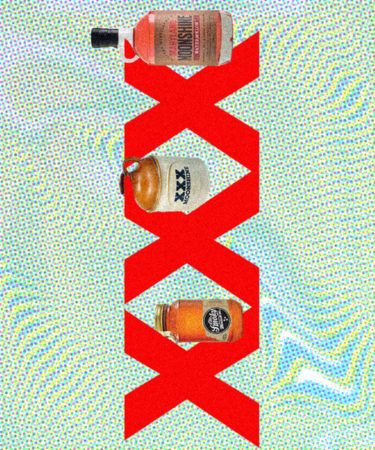Moonshine holds a special place in Americans’ hearts. Tales of pot stills hidden deep in Appalachian forests, Mob-driven rum-runners racing through the night, and occasional blindness (and even death) ignite an odd combination of fauxstalgia, patriotism, and fear.
Misconceptions around moonshine, a once-illicit liquor that’s still made legally and illegally today, proliferate on the internet. Part of the misconception around the liquid’s health risks revolves around the famous “XXX” label, and why it’s even there in the first place. Its explanation is simple enough — and has nothing to do with signifying it may be poison, as cartoons might have you believe — but whether anyone can prove its definition is up for debate.
“The XXX symbol was historically used by ‘shiners to signify that their hooch had been run through the still three times, signaling to buyers that it was pure and strong alcohol,” Brendan McAlpine, owner of Dutch’s Spirits, writes VinePair in an email.
“Lacking sophisticated distilling equipment, the result of a first distillation was lower in alcohol and not terribly good tasting. The second and third runs were used to purify the spirit, increasing its purity and strength,” he says.
McAlpine and many others have made this assertion. Spirits websites and blogs, including Liquor.com, Moonshine Heritage, The Goods, and Spoon University, have also attributed the XXX to triple-distilled.
But Laura Fields, event organizer at Delaware Valley Fields Foundation, who has written on the topic for the blog Dram Devotee, believes it’s impossible to know for sure where the XXX originally stems from. “It is likely a bit more legend than fact,” she says.
“There were no jars or bottles to use for whiskey until after the 1860s, so whiskey was dispensed from barrels at the bars/pubs into stoneware jugs,” Fields writes VinePair in an email. “Marks on jugs could have been etched into the clay when they were made, which would indicate the maker.” She adds that African potters used Xs in their makers marks as well.
Fields and many others tend to agree, though, that the XXX “was a quick and easy way to show the drinker of the whiskey that it was three-times distilled, and of higher quality (stronger and purer) than the other guy’s whiskey,” she writes.
Among these neatly packaged explanations, however, none point to factual evidence of the XXX label. Photographs of moonshine production and raids depict clear glass jugs and Mason jars with no markings at all.
Then, there are other common associations with XXX, spanning pornography to straight-edge hardcore subculture. In the Netherlands, XXX is the mark of the Amsterdam flag. And in various cases, it’s seen on beer labels, too.
Ballantine Ale, produced by Pabst Brewing, has XXX on its label. Chris Middleton, a whiskey history enthusiast and commenter on BourbonVeach.com, believes the symbol finds its roots in 18th-century Britain, where “X” denoted a strong beer that cost 10 shillings. By the mid-1800s, he writes, the X was adapted to simply mean “ale,” while XXX meant “porter,” and XXXX meant “stout,” each increasing with intensity.
“Some English colonists may have marked their whiskey the way they marked their beer, to show strength,” Fields writes. In Belgium, “There’s the enkle, dubbel, tripel Trappist monk theory. In all honesty, it could be all of the above or none of the above. American lore tends to marry lots of ideas together.”
Perhaps, unlike moonshine itself, we’ll never have enough proof.
Felicia LaLomia contributed to this article.
